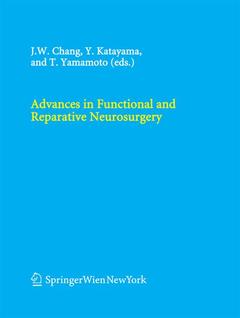Neurorehabilitation.- Early rehabilitation of higher cortical brain functioning in neurosurgery, humanizing the restoration of human skills after acute brain lesions.- Involuntary movement disorders.- Deep brain stimulation as a functional scalpel.- Feed-forward control of post-stroke movement disorders by on-demand type stimulation of the thalamus and motor cortex.- Pallidal high-frequency deep brain stimulation for camptocormia: an experience of three cases.- Multimodal neurosurgical strategies for the management of dystonias.- Detection of boundaries of subthalamic nucleus by multiple-cell spike density analysis in deep brain stimulation for Parkinson’s disease.- Microelectrode recording: lead point in STN-DBS surgery.- Follow-up of bilateral subthalamic deep brain stimulation for Parkinson’s disease.- Rapid subthalamic nucleus deep brain stimulation lead placement utilising CT/MRI fusion, microelectrode recording and test stimulation.- FDG-PET study of the bilateral subthalamic nucleus stimulation effects on the regional cerebral metabolism in advanced Parkinson disease.- Pain control.- Stimulation of primary motor cortex for intractable deafferentation pain.- Fifteen year experience of intrathecal baclofen treatment in Japan.- Electrical stimulation of the anterior cingulate cortex in a rat neuropathic pain model.- Long term follow-up results of dorsal root entry zone lesions for intractable pain after brachial plexus avulsion injuries.- Endogenous and exogenous modulators of potentials evoked by a painful cutaneous laser (LEPs).- Long term results from percutaneous radiofrequency neurotomy on posterior primary ramus in patients with chronic low back pain.- Epilepsy.- Chronic deep brain stimulation of subthalamic and anterior thalamic nuclei for controllingrefractory partial epilepsy.- Vagus nerve stimulation in pediatric intractable epilepsy: a Korean bicentric study.- Seizure control of Gamma Knife radiosurgery for non-hemorrhagic arteriovenous malformations.- Surgical resection of cavernous angiomas located in eloquent areas — clinical research.- Spinal cord.- Spinal cord stimulation and cerebral haemodynamics.- Idiopathic syringomyelia: case report and review of the literature.- Cell transplantation and nerve grafting.- Migration of bone marrow stem cells in ischaemic brain.- The behavioral effect of human mesenchymal stem cell transplantation in cold brain injured rats.- Effect of human mesenchymal stem cell transplantation combined with growth factor infusion in the repair of injured spinal cord.- Stem cell therapy in stroke: strategies in basic study and clinical application.- Neural prosthesis in the wake of nanotechnology: controlled growth of neurons using surface nanostructures.- A new and simple transection knife for study of neurodegeneration and neuroregeneration in animal model.





